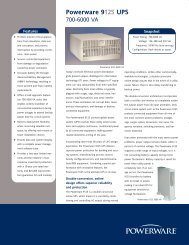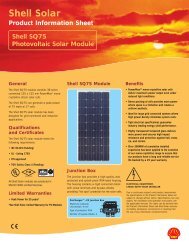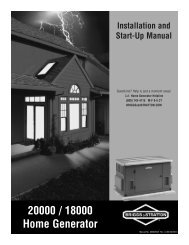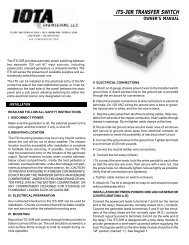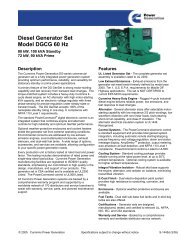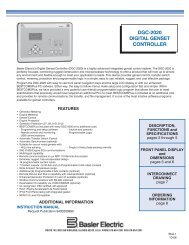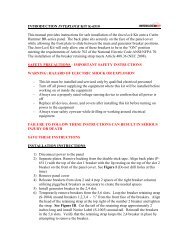O & M Manual for the Eaton ATC-100 Automatic Transfer Switch ...
O & M Manual for the Eaton ATC-100 Automatic Transfer Switch ...
O & M Manual for the Eaton ATC-100 Automatic Transfer Switch ...
Create successful ePaper yourself
Turn your PDF publications into a flip-book with our unique Google optimized e-Paper software.
O&M <strong>Manual</strong> <strong>for</strong> <strong>the</strong> <strong>Eaton</strong> <strong>ATC</strong>-<strong>100</strong><br />
<strong>Automatic</strong> <strong>Transfer</strong> <strong>Switch</strong> Controller<br />
2.6 Specification Summary<br />
Table 1. <strong>ATC</strong>-<strong>100</strong> Specifications.<br />
Input Control Voltage 95 to 145 Vac 50/60 Hz<br />
Voltage Measurements of Utility VAB Generator VAB<br />
Utility VBC<br />
Generator VBC<br />
Utility VCA<br />
Generator VCA<br />
Voltage Measurement Range 0 to 575 Vac RMS (50/60 Hz)<br />
Voltage Measurement Accuracy ± 1% of Full Scale<br />
Frequency Measurements of<br />
Generator<br />
Frequency Measurement Range 40 Hz to 70 Hz<br />
Frequency Measurement Accuracy ± 0.3 Hz Over <strong>the</strong> Measurement Range<br />
Undervoltage Dropout<br />
80% of <strong>the</strong> Nominal System Voltage<br />
Undervoltage Pickup<br />
90% of <strong>the</strong> Nominal System Voltage<br />
Underfrequency Dropout Range 90% of <strong>the</strong> Nominal System Frequency<br />
Underfrequency Pickup Range 95% of <strong>the</strong> Nominal System Frequency<br />
Overfrequency Dropout Range 115% of <strong>the</strong> Nominal System Frequency<br />
Overfrequency Pickup Range 110% of <strong>the</strong> Nominal System Frequency<br />
Operating Temperature Range -20 to +70°C (-4 to +158°F)<br />
Storage Temperature Range<br />
-30 to +85°C (-22 to +185°F)<br />
Operating Humidity<br />
0 to 95% Relative Humidity (Non-condensing)<br />
Operating Environment<br />
Resistant to Ammonia, Methane, Nitrogen, Hydrogen,<br />
and Hydrocarbons<br />
Generator Start Relay<br />
5 A, 1/6 HP @ 250 Vac<br />
5 A @ 30 Vdc with a 150 W Maximum Load<br />
K1, K2 Relays 10 A, 1-3 HP @ 250 Vac<br />
10 A @ 30 Vdc<br />
Applicable Testing<br />
UL Recognized Component<br />
UL <strong>100</strong>8, UL 991 Environmental<br />
IEC 6<strong>100</strong>0-4-2, 6<strong>100</strong>0-4-3, 6<strong>100</strong>0-4-4, 6<strong>100</strong>0-4-5,<br />
6<strong>100</strong>0-4-6, 6<strong>100</strong>0-4-11<br />
CISPR 11, Class B<br />
FCC Part 15, Class B<br />
Enclosure Compatibility NEMA 1, NEMA 3R, and NEMA 12<br />
UV Resistant <strong>ATC</strong>-<strong>100</strong> Faceplate<br />
Section 3: Operation<br />
Instructional Booklet<br />
Effective: May 2006 Page 9<br />
3.1 General<br />
This section specifically describes <strong>the</strong> operation and functional<br />
use of <strong>the</strong> <strong>ATC</strong>-<strong>100</strong> . The practical use of and operation within<br />
each category will be discussed. In this section, it is assumed<br />
that prior sections of this manual were reviewed and that <strong>the</strong><br />
operator has a basic understanding of <strong>the</strong> hardware.<br />
The <strong>ATC</strong>-<strong>100</strong> provides <strong>for</strong> automatic transfer and re-transfer from<br />
source to source. It provides a summary of <strong>the</strong> <strong>ATC</strong>-<strong>100</strong> intelligence<br />
and supervisory circuits that constantly monitor <strong>the</strong> condition<br />
of both <strong>the</strong> utility and generator power sources, thus<br />
providing <strong>the</strong> required intelligence <strong>for</strong> transfer operations. These<br />
circuits, <strong>for</strong> example, automatically initiate an immediate transfer<br />
of power when <strong>the</strong> power fails or <strong>the</strong> voltage level drops below a<br />
preset value.<br />
3.2 Operating Voltage and Measurements<br />
The <strong>ATC</strong>-<strong>100</strong> operates with control power from 95 to 145 Vac<br />
(120 Vac ± 20%). The <strong>ATC</strong>-<strong>100</strong> operates on single and 3-phase systems<br />
with selectable frequency settings of 50 or 60 Hz.<br />
The <strong>ATC</strong>-<strong>100</strong> can per<strong>for</strong>m <strong>the</strong> time delay engine start function<br />
without control power.<br />
The <strong>ATC</strong>-<strong>100</strong> operates directly from <strong>the</strong> line sensing inputs of <strong>the</strong><br />
utility and generator power sources. The nominal operating system<br />
input is jumper-selectable from 120 to 480 Vac. The standard<br />
system assumes that neutral is available and that <strong>the</strong><br />
switching device can <strong>the</strong>re<strong>for</strong>e be powered from an available<br />
120 Vac source. If a neutral conductor is not available,120 Vac<br />
is created by an external trans<strong>for</strong>mer.<br />
All voltage monitoring and measurements are true RMS measurements.<br />
3.3 Typical <strong>Transfer</strong> Operation<br />
A typical transfer request will begin with a utility outage (utility<br />
voltage falls below <strong>the</strong> 80% dropout level), a System Test, or a<br />
Generator Test with Load <strong>Transfer</strong>. After Time Delay Engine Start<br />
(TDES) times out, <strong>the</strong> Generator Start relay will energize which<br />
closes its Normally Open contacts and opens its Normally Closed<br />
contacts.<br />
When <strong>the</strong> generator source meets <strong>the</strong> requirements to be considered<br />
available, <strong>the</strong> Time Delay Normal to Emergency (TDNE) timer<br />
will start timing. After TDNE times out, <strong>the</strong> K2 relay contacts will<br />
close until <strong>the</strong> Generator Connected input is closed. Once <strong>the</strong><br />
Generator Connected input is satisfied (load is connected to generator),<br />
<strong>the</strong> K2 relay contacts will open.<br />
When <strong>the</strong> utility becomes available (utility voltage is above <strong>the</strong><br />
90% pickup level), <strong>the</strong> Time Delay Emergency to Normal (TDEN)<br />
timer will start timing. After TDEN times out, <strong>the</strong> K1 relay contacts<br />
will close until <strong>the</strong> Utility Connected input is closed. Once<br />
<strong>the</strong> Utility Connected input is satisfied (load is connected to utility),<br />
<strong>the</strong> K1 relay contacts will open and <strong>the</strong> Time Delay Engine<br />
Cooldown (TDEC) timer will start timing. When TDEC times out,<br />
<strong>the</strong> Generator Start relay will de-energize which opens its Normally<br />
Open contacts and closes its Normally Closed contacts.<br />
3.4 Test Modes<br />
There are three test modes:<br />
1. Engine Start – a no load generator test;<br />
2. System Test – a generator test with load transfer; and<br />
3. Generator Test – a programmed generator test with or<br />
without load transfer.<br />
IB01602019E<br />
For more in<strong>for</strong>mation visit: www.eatonelectrical.com






